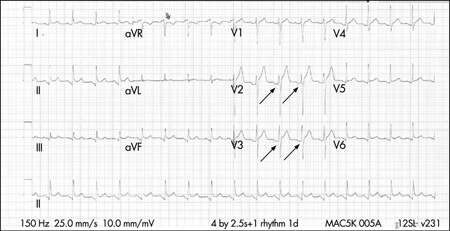Resumo
Definição
História e exame físico
Principais fatores diagnósticos
- chest pain
- pericardial rub
Outros fatores diagnósticos
- fever
- myalgias
- signs of right-sided heart failure
Fatores de risco
- male sex
- age 20 to 50 years
- transmural myocardial infarction (MI)
- cardiac surgery
- neoplasm
- viral and bacterial infections
- uremia or on dialysis
- systemic autoimmune disorders
- pericardial injury
- mediastinal radiation
Investigações diagnósticas
Primeiras investigações a serem solicitadas
- ECG
- serum troponin
- pericardial fluid/blood culture
- erythrocyte sedimentation rate (ESR)
- CRP
- serum BUN
- CBC
- chest x-ray
- echocardiography
Investigações a serem consideradas
- chest CT or cardiac MRI
- pericardiocentesis/biopsy
Algoritmo de tratamento
suspected pericarditis
purulent
non-purulent
recurrent disease
Colaboradores
Consultores especialistas
Antonio Abbate, MD, PhD
Professor of Cardiology
Division of Cardiovascular Medicine
University of Virginia
Charlottesville
VA
Declarações
AA has received grant support and consultant fees from Applied Clinical Intel, Astra Zeneca, Cromos Pharma, Eli Lilly, Implicit Biosciences, Janssen, Kiniksa, Merck, Novartis, Novo Nordisk, Olatec, R-Pharm, and Serpin Pharma.
Agradecimentos
BMJ Best Practice would like to gratefully acknowledge Dr Katherine Wu MD, a previous contributor to this topic.
Declarações
KW declares that she has no competing interests.
Revisores
Susan Denfield, MD
Associate Professor of Pediatrics
Division of Pediatric Cardiology
Texas Children's Hospital
Houston
TX
Declarações
SD declares that she has no competing interests.
Shrilla Banerjee, MBMD, MRCP
Consultant Cardiologist
East Surrey Hospital
Surrey and Sussex NHS Trust
Redhill
UK
Declarações
SB declares that she has no competing interests.
Créditos aos pareceristas
Os tópicos do BMJ Best Practice são constantemente atualizados, seguindo os desenvolvimentos das evidências e das diretrizes. Os pareceristas aqui listados revisaram o conteúdo pelo menos uma vez durante a história do tópico.
Declarações
As afiliações e declarações dos pareceristas referem--se ao momento da revisão.
Referências
Principais artigos
Adler Y, Charron P, Imazio M, et al. 2015 ESC Guidelines for the diagnosis and management of pericardial diseases. Eur Heart J. 2015 Nov 7;36(42):2921-64.Texto completo Resumo
Chiabrando JG, Bonaventura A, Vecchié A, et al. Management of acute and recurrent pericarditis: JACC State-of-the-Art Review. J Am Coll Cardiol. 2020 Jan 7;75(1):76-92.Texto completo Resumo
Gulati M, Levy PD, Mukherjee D, et al. 2021 AHA/ACC/ASE/CHEST/SAEM/SCCT/SCMR Guideline for the evaluation and diagnosis of chest pain: a report of the American College of Cardiology/American Heart Association Joint Committee on clinical practice guidelines. Circulation. 2021 Nov 30;144(22):e368-e454.Texto completo Resumo
Artigos de referência
Uma lista completa das fontes referenciadas neste tópico está disponível para os usuários com acesso total ao BMJ Best Practice.

Diagnósticos diferenciais
- Pulmonary embolism (PE)
- Myocardial infarction or ischemia
- Pneumonia
Mais Diagnósticos diferenciaisDiretrizes
- 2025 ACC/AHA/ACEP/NAEMSP/SCAI guideline for the management of patients with acute coronary syndromes
- 2021 AHA/ACC/ASE/CHEST/SAEM/SCCT/SCMR guideline for the evaluation and diagnosis of chest pain
Mais DiretrizesVideos
Venepuncture and phlebotomy: animated demonstration
How to perform an ECG: animated demonstration
Mais vídeosFolhetos informativos para os pacientes
Pericarditis
Mais Folhetos informativos para os pacientesConectar-se ou assinar para acessar todo o BMJ Best Practice
O uso deste conteúdo está sujeito ao nosso aviso legal